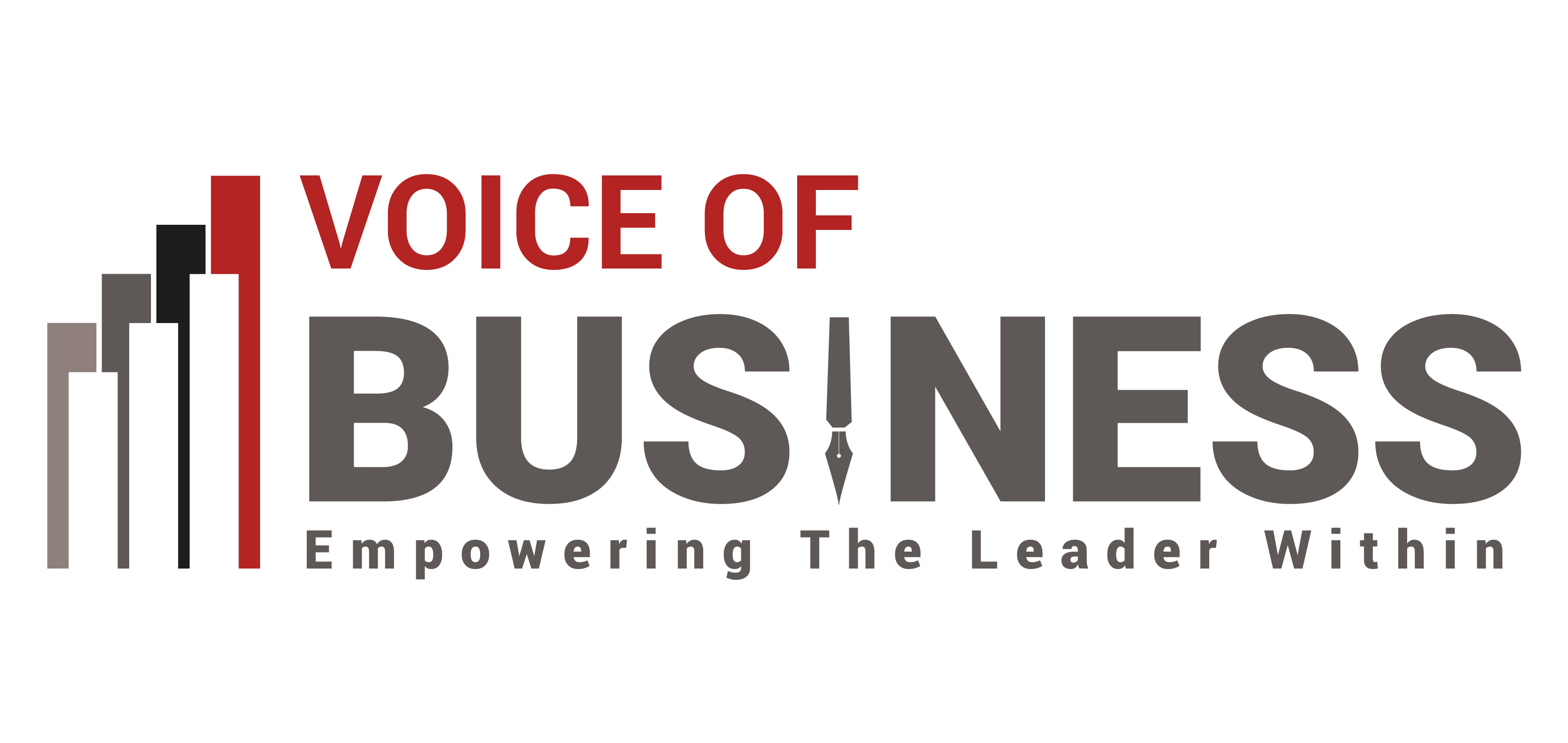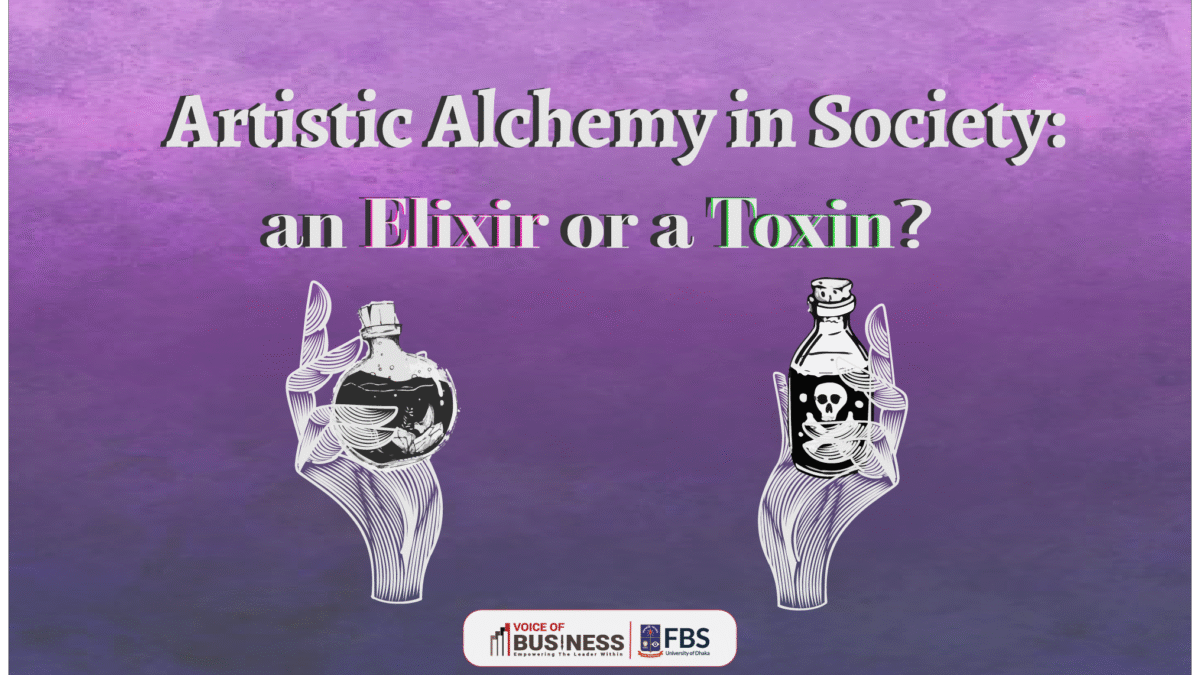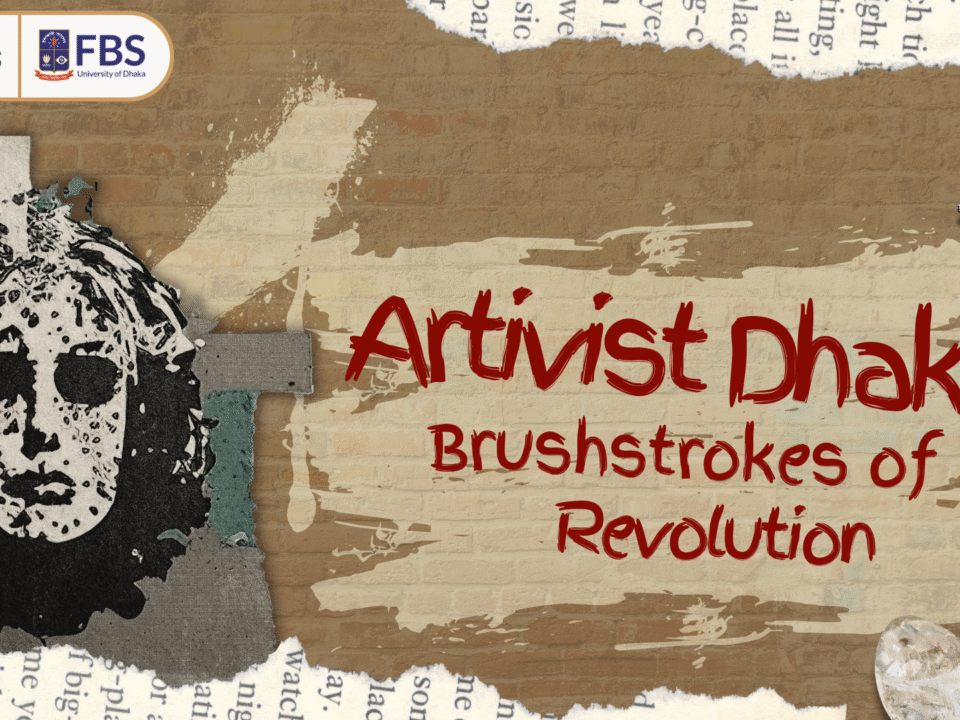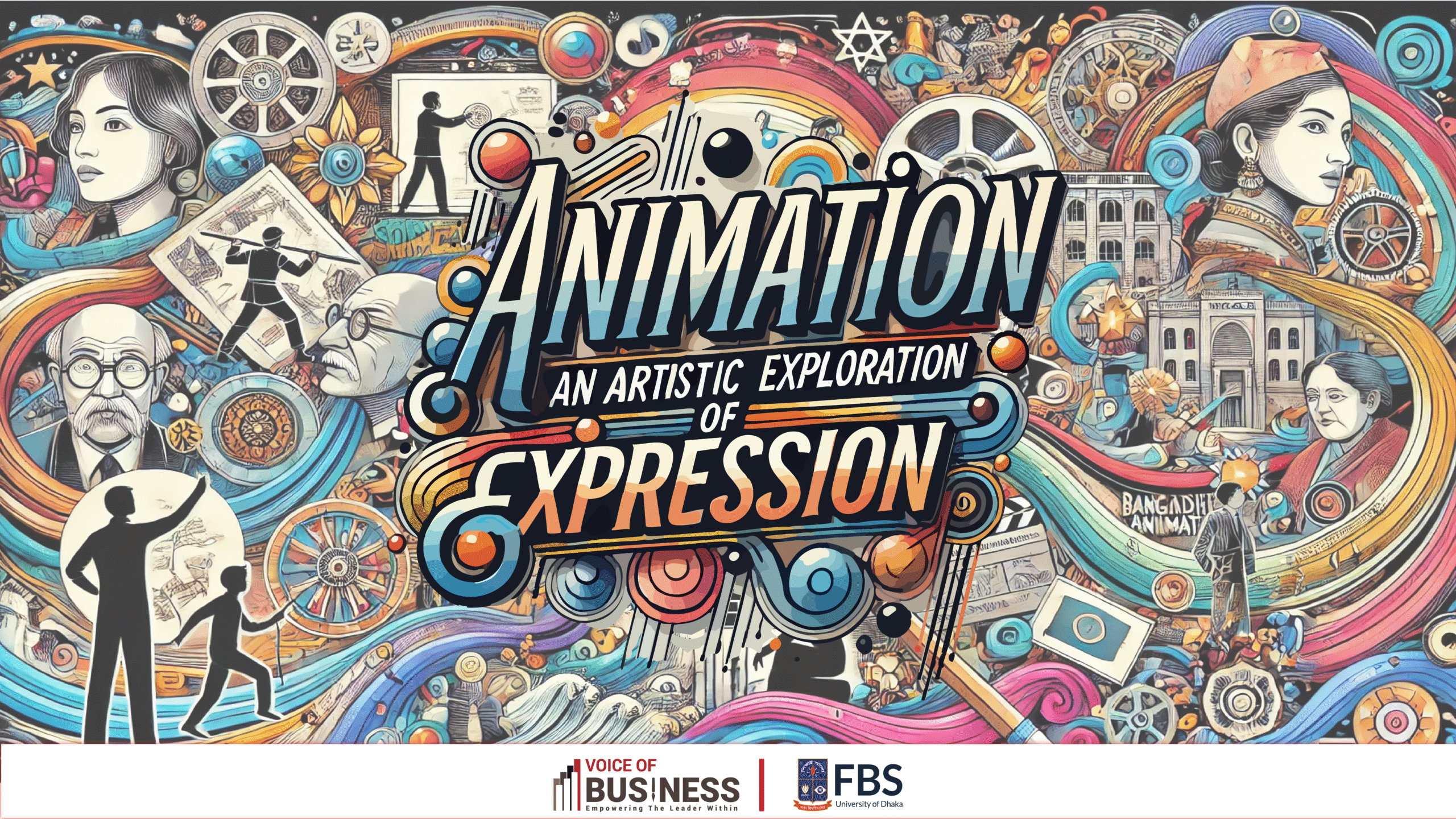Artistic Alchemy in Society: An elixir or a toxin?

Echoes of Art
June 3, 2025The Singing Robins of The Sundarbans
June 3, 2025
Cartoonist: Rafiqun Nabi (Ranabi)
Artistic expression has historically been a powerful catalyst for social commentary and transformation in Bangladesh, addressing issues like corruption, poverty, gender inequality, and environmental challenges. Through music, drama, and literature, art has shaped movements and protests, embedding itself in the nation’s collective consciousness. As Frederick Douglass noted during the American Civil War in his speech “Pictures and Progress,” art has the power to subtly influence thought and inspire change. This is not about the elite art world but art that engages


society, addressing key issues and resonating with the collective experiences and struggles of the people. By doing so, it ignites a shift towards a more just and equitable society.
Many artists today are inspired by reality rather than mere aesthetics, finding art for art’s sake insufficient in addressing complex global issues. Socially and politically engaged art employs various media—sculpture, painting, film, video, performance, and installation—to tackle topics like democracy, human rights, capitalism, and the environment etc, challenging power structures and media stereotypes. In Bangladesh, art forms like visual arts, literature, music, and public monuments have critiqued social issues and advocated for change in the past. These give voice to the marginalised and act as a societal barometer and moral resistance. As Kendell Geers says, “Art shakes the tree, and then all the monkeys fall out.” Through soft power, artistry cultivates dialogue, reconciliation, and understanding, making its impact immeasurable.
Swadhin Bangla Betar Kendra Artists
Bangladesh’s history is marked by exploitation under British colonial rule and later by Pakistan, enduring economic and cultural suppression. British resource depletion triggered events like the Bengal Famine of 1943, while Pakistani repression sparked uprisings such as the Language Movement of 1952, culminating in the Liberation War of 1971 and eventual independence. Throughout these struggles, Bangladesh’s cultural and artistic heritage played a leading role in supporting solidarity and resistance. Patriotic songs from Swadhin Bangla Betar Kendra and symbols like the Shaheed Minar unified the nation, transcending religious and ethnic divisions to restore communal harmony. This cultural unity bridged class inequality, reinforcing a collective nationalistic identity and enhancing awareness of rights and freedoms. Monuments like the Shaheed Minar and Jatiyo Smriti Soudho stand as enduring symbols of resilience,
2

commemorating historical events and stimulating national unity and activism while manifesting Bangladesh’s history and aspirations for a better future.
Artists: Nitun Kundu (top-left), Nitun Kundu (bottom-left), Devdas chakraborty (bottom-right),
‘এই জানোয়ারদের হত্যা করতে হবে’- Quamrul Hasan
Visual arts, including painting and sculpture, vividly portrayed the struggles of peripheral communities while critiquing political corruption and environmental degradation. Artists like Zainul Abedin and SM Sultan captured these themes through powerful works such as “The Struggle” and “The Weeping Woman,” respectively, which showcased the resilience of the poor and the burdens faced by rural women. During war & Post-independence, artists like Quamrul Hassan and Rafiqun Nabi continued to influence public sentiment and resistance through their art, with Yahya Khan’s caricature & ‘Tokai’ sequentially, documenting the horrors of the Liberation War and appraising societal injustices. These artistic representations celebrated freedom united Bangladeshis, and promoted societal reform, reflecting the nation’s journey towards tenacity and progress.
3

Literature and film in Bangladesh also served as formidable tools for resolving social issues by transforming abstract concerns into tender narratives. Satyajit Ray’s “Pather Panchali,” based on Bibhutibhushan Bandyopadhyay’s novel, clearly portrays the struggles of a rural family, highlighting their hardships and aspirations. Similarly, Rabindranath Tagore’s “Char Oddhay” and Hasan Azizul Haque’s “Agunpakhi,” along with films like “Meghe Dhaka Tara,” “Mahanagar,” and “Matir Moina,” scrutinise personal desires and societal constraints, exploring relationships, ambitions, and cultural norms within Bengali context. These works deeply engage with human emotions and public issues, propelling introspection and offering profound insights into the human condition and the socio-political landscapes that mould lives.
Movie Poster: Meghe Dhaka Tara (left), Book Title: Agunpakhi (right)
During Bangladesh’s Liberation War, music was essential through patriotic songs aired by Swadhin Bangla Betar Kendra, bridging people and boosting morale with themes of sacrifice and hope in songs like “Ek Shagor Rokter Binimoye” and “Purbo Digonte Surjo Utheche.” The Bangladesh Mukti Sangrami Shilpi Sangstha performed in refugee camps and liberated areas, motivating freedom fighters and civilians through patriotic songs, puppet shows, and dramas. Modern songs such as “Bangladesh” by James and “Rail Line er Oi Bostite” continued
4

approaching political corruption and social inequality, mobilising people emotionally and driving social movements forward. Moreover, mediums like Public art, graffiti in Dhaka such as ‘Subodh’ and murals questioning conscience’s whereabouts (Bibek Koi), use satire and humour to advocate for peace and civil rights, sparking discussions among diverse groups in public spaces.
A performance of Bangladesh Mukti Sangrami Shilpi Sangstha
Aesthetic experiences wield a transformative power that rational arguments often lack, driving societal progress and justice. Art operates as a soft power, nurturing exchange, reconciliation, and understanding through its profound impact on individuals. As Anthony Gormley noted, “Art is about an individual’s expectation of and use of their own freedom to act”, featuring how artistic expressions, inherently optimistic, empower individuals to effect collective change. By challenging norms and celebrating human imagination, creative outputs shape societal conscience and perception. They transcend rational defences, deepening empathy, inspiring action, and uniting diverse communities, through compelling visual narratives. This affinity transforms passive observers into active agents of social change, as historically evidenced in Bangladesh.
Thus, upholding the social criticism of injustices and presenting alternative perspectives, art prompts a reevaluation of values and incites action towards a more just and equitable world.
5
Does the absence of inventive minds disrupt social cohesion and harmony? This spotlights the urgent need to settle the ‘famine of interest,’ where we have forgotten to use our spine and creative resources simultaneously.
While alignment of interests does not guarantee alignment of compatibility, we must not be demotivated by the rotten systems and malpractices. Our artistic pursuits must translate our aspirations into action, transforming dreams into reality and treating the crisis of lacking creative minds through self-redemption and awareness. By harnessing artistic mediums, we can foster personal integrity and empowerment, creating a peaceful milieu. As the lyrics suggest, “What is a man, what has he got, if not himself, then he has naught,” emphasising the importance of integrity and personal enablement. Therefore, art’s vision of new possibilities becomes imperative for piloting social change and inspiring a harmonious and sustainable future.
Author: Shah Feaz Ahsan Pranon,
Development studies, University of Dhaka
References:
1. Rahman, M. (Ed.). (2015). Masterpieces of Bangladeshi Art: A Collection of Paintings by Renowned Artists. Dhaka: Bangla Publishers. Retrieved from https://examplelink.com/masterpieces-of-bangladeshi-art
2. Geers, K. (2001). Art shakes the tree, and then all the monkeys fall out. Art Journal, 60(3), 76-83. https://doi.org/10.1080/00043249.2001.10791834
3. Hasan, M. (2019). Art and Liberation in Bangladesh: From Language Movement to Contemporary Protests. Retrieved from https://www.bangladeshart.com/art-and-liberation
4. Smithsonian Institution. (n.d.). Art and Social Change: Contemporary Art in Bangladesh. Retrieved from https://www.si.edu/exhibitions/art-social-change-banglades
5. UNICEF Bangladesh. (2020). Arts for Social Change: Promoting Rights, Participation and Social Justice. Retrieved from https://www.unicef.org/bangladesh/en/arts-social-change



